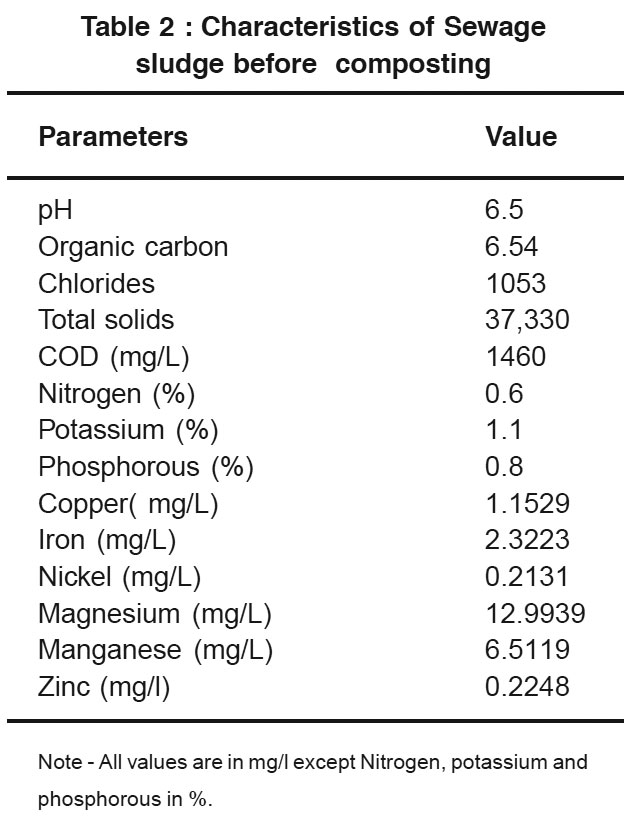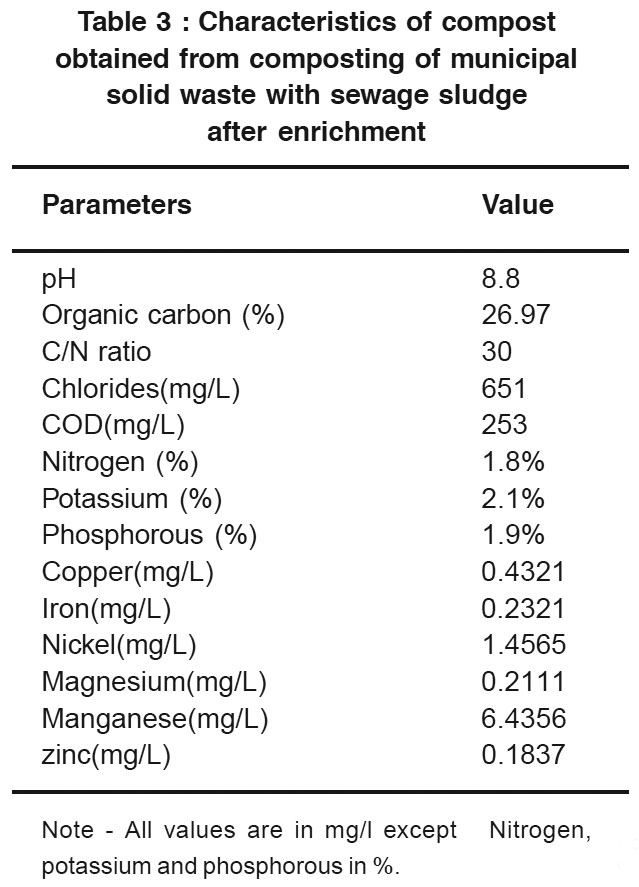Effectiveness of sewage sludge in composting process of municipal solid waste
S.D. Narkhede1 * , V.D. Pawar1 , N.J. Patil1 and S.B. Attarde1
1
School of Environmental and Earth Sciences,
North Maharashtra University,
Jalgaon,
India
DOI: http://dx.doi.org/10.12944/CWE.4.1.27
Present study determines that 60 days degradation period used for composting of Municipal solid waste with sewage sludge was beneficial as rate of composting process has enhances due to optimum favorable conditions provided as well the catalyst used for the composting process as sewage sludge have shown tremendous progress in increasing the fertility of compost compared with the control samples. Reduction in heavy metal content like Cu, Fe, Ni, Mg, Mn, Zn etc has been observed after the composting process
Copy the following to cite this article:
Narkhede S.D, Pawar V.D, Patil N.J, Attarde S.B. Effectiveness of sewage sludge in composting process of municipal solid waste. Curr World Environ 2009;4(1):171-174 DOI:http://dx.doi.org/10.12944/CWE.4.1.27
Copy the following to cite this URL:
Narkhede S.D, Pawar V.D, Patil N.J, Attarde S.B. Effectiveness of sewage sludge in composting process of municipal solid waste. Curr World Environ 2009;4(1):171-174. Available from: http://www.cwejournal.org/?p=927
Download article (pdf) Citation Manager Publish History
Select type of program for download
| Endnote EndNote format (Mac & Win) | |
| Reference Manager Ris format (Win only) | |
| Procite Ris format (Win only) | |
| Medlars Format | |
| RefWorks Format RefWorks format (Mac & Win) | |
| BibTex Format BibTex format (Mac & Win) |
Article Publishing History
| Received: | 2009-03-20 |
|---|---|
| Accepted: | 2009-04-29 |
Introduction
With the increasing of population quantity as well as industry and economy developing, the output of the municipal solid wastes (MSW) has been increasing. At present, the output of MSW has been exceeded a hundred million tons in most cities In fact, the MSW output has been increasing at 10% each year and now it has been accumulated gradually to ninety hundreds million tons in the past years. Most cities have been surrounded by the MSW ( Zhao & Liu 2005), Because the calorific value of the MSW in is lower than that in other countries, incineration treatment will be much expensive (Zurbrugg, & Sharatchandra 2004). On the other hand sanitation landfill would occupy a lot of lands, and lead to two-step solution by less developed technology. In recent years, the technology of the MSW microbial composting has been accepted gradually by World citizen, because the organic matter content of MSW exceed 60%, and water content is about 50%, after the MSW was classified by machines, the residual organic matter is suitable for composting, and the composting production could be served as soil fertilizer. (Arroyo & Hornedo 2002).
Disposal of municipal sewage sludge in a manner which is not harmful to the environment, minimizes health risks, and is economically feasible has become a critical concern in many areas of the world. Many cities are turning to composting as a means of sewage sludge disposal and resource recovery. (Alidadi & parvaresh 2005) , By 1983, 61 sewage sludge composting plants were in full-time operation in the United States, and 29 plants were under construction Composting is the conversion, by microorganisms, of complex mixtures of quickly degradable organic materials to more stable, humified materials, usually in a warm, moist, and relatively aerobic environment. The borderline between waste and compost has not been precisely defined by generally agreed upon quantitative parameters, but it is assumed that composts should not reheat anaerobically during curing and storage, producing foul odors (Adewumi and Ogedengbe 2005). Composting satisfies the health and aesthetic aspects of waste disposal by destroying almost all pathogens. In addition, the product is agriculturally or horticultural beneficial as a soil conditioner and fertilizer Much of the research on composting has focused on the changes in the physical and chemical parameters of the compost, primarily in an effort to find a simple and reliable indicator of compost maturity and to improve the efficiency of the process. However, it is important to remember that the compost micro biota determines the rate of composting and the quality of the product.
The term co-composting means the composting of two or more raw materials together (Grazia, & Tittonell 2007). In the case of organic part of MSW and sewage sludge, this kind of composting is advantageous because the two waste materials complement each other well. The sewage sludge is high in nitrogen content and moisture and the MSW is high in organic (carbon) content and has good bulking quality. Proper mixing of the same ensures and optimum C:N ratio to enhance the biodegradation process.
Material and Methods
The municipal solid waste is collected in a big tough bag from the local market area situates at pimprala and dewatered sewage sludge was collected from sewage nala in Jalgaon city physiochemical analysis was done by standard method (APHA 1995) Characterization of solid waste and sewage was done before the composting process in order to know the biodegradable potential property of both the products. For solid waste, analysis was done by crushing waste initially and further making suspension with distilled water as 1:5 and taking supernant for analysis (Taiwoo & Oso 2004) .parameters like- pH; Conductivity ,Temperature, moisture content, organic carbon, organic matter , chloride, phosphate phosphorous, potassium etc. were analyzed in which pH was analyzed by pH meter ,temperature by bulb thermometer ,Organic carbon was estimated by Walkey and Black method, Chlorides by Mohr's method, phosphate by calorimetrically and potassium by AAS Spectrophotometer. preparation of pilot composting plant was done The composting Bins were used to perform the experiment, Size ranges as 1x 2 ft bins of same size were used for the study purpose. Bins were placed in such a way that direct sunlight will not fall on it, Proper favorable conditions were maintain for composting process. 60 days degradation period was effective for composting process for MSW with Sewage sludge.
 |
Table 1 : Physiochemical characteristics of Municipal solid waste before composting with sewage sludge Click here to view table |
Heavy metal analysis was done twice firstly to know the Sewage sludge content and after the compost obtained. heavy metal like Zn ,Cu ,Mg Ni, Mn,& Fe present in the sewage sludge has been analyzed, as well as after completion of composting process how much reduction has been occur due to composting technique was determined using AAS (Kumar and Bhattacharya 2007). The potentially toxic heavy metals like Zn, Cu, Mg Ni, Mn,& Fe was determined in the product by using AAS spectrophotometer.
Results and Discussion
In the above study of composting process (Table 1) shows initial characterization of MSW was done in order to know the content present in it. pH estimated was acidic ,moisture content was approximately favorable for composting process, Organic carbon content was 29% as for C/N ratio carbon content should be minimum 25%,Chemical oxygen demand COD was too high also as nutrient NPK ratio was in average range.
 |
Table 2 : Characteristics of Sewage sludge before composting Click here to view table |
Sewage sludge having slightly acidic pH with carbon content was too low 6.54% again chloride content was also very high, Total solids were estimated by addition of Total dissolved solids and total suspended solids which were present in tremendous high amount NPK content in the sewage sludge( Pearson & Gnadhi 2004) was 0.6%,1.1% and 0.8% ,also heavy metal content present in the sewage sludge were also analyzed in which magnesium was too high in sludge also manganese content was also high, nickel and zinc were present in trace amount in the sludge shown in table 2.
 |
Table 3 : Characteristics of compost obtained from composting of municipal solid waste with sewage sludge after enrichment Click here to view table |
In the (Table 3) the compost obtained by composting process after enrichment given for MSW and Sewage sludge show tremendous variation in the carbon content before composting was too low, and also the key nutrient parameters in the compost also get increase after composting and a quality of compost was obtained fro the process( Dumontet & Dinel 1999). Reduction in COD content in the compost has been observed which is beneficial for compost
As C/N ratio in a typical compost is 24/3 (Diaz & Savage 1993), as 30/5 was obtained in the above composting process more than typical range so a good quality of compost has been obtained by using sewage sludge used as a catalyst. Thus from the above practice it can be concluded that co-composting of MSW with sewage sludge is an ecofriendly approach and also beneficial source for soil fertility by using such a quality of compost in agricultural sectors.
Compost obtained from such kind of waste is an effective way of management of all sort of municipal biodegradable waste. This practices is eventually coming from ancient times but certain drawback such as large time required for the process for decomposition etc.co-composting practice is a solution for such disadvantages ,here with in 55-60 days a quality of compost has been obtained with the addition of sewage sludge
Acknowledgements
​​​​​​​
This investigation was carried out by the Department of Environmental Science, and sciences, North Maharashtra University, Jalgaon. we are really thankful to our Head for that supporting our work throughout the process and also thankful to all the members in the department.
References
- Zhao, and H. Liu., A Study of Composting System of Municipal Solid Waste with Bio-surfactant, The J. of American Science, 2(1): 66-70 (2005).
- Zurbrugg, S. Drescher, A. Patel, and H. C. Sharatchandra., Decentralized Composting of Urban Waste- An Overview of Community and Private Initiatives in Indian Cities, Waste Management, (2004) 24: 655-662.
- Arroyo, P. Cots, M. D. I. Hornedo, B. Rodriguez, B. Beringola, and V. M. Sanchez., Sewage Sludge Compost Fertilizer Effect on Maize Yield and Soil Heavy Metal Concentration, Rev. Int. Conta. Ambient, (2002) 18(3): 147-150.
- Alidadi, A. R. Parvaresh, M. R. Shamanshouri, and H. Pourmoghadas., Combined Compost and Vermicomposting Process in the Treatment and Bioconversion of Sludge, Iran J. of Environ. Health Sci. Eng., (2005) 2(4): 251- 254.
- Adewumi, M. O. Ogedengbe, J. A. Adepetu, and P. O. Aina., Aerobic Composting of Municipal Solid Waste and Poultry Manure, J. of Applied Sciences Research, (2005) 1(3): 292-297.
- Grazia, Pablo A. Tittonell and Angel Chiesa., The Effect of Substrates with Compost and Nitrogenous Fertilization on Photosynthesis, Precocity and Pepper (Capsicum annum) Yield, Cinecia e Investigacion Agarica, (2007) 34(3): 151-160.
- APHA, American Public Health Association., Standard Methods for Examination of Water and Wastewater; 16’th Edition, Washington DC (1995).
- Taiwoo and B. A. Oso., Influence of Composting Techniques on Microbial Succession, Temerature, and pH in a Composting Municipal Solid Waste, African J. of Biotechnology, (2004) 3(4): 239-243.
- Kumar, J. K. Bhattacharya, S. Das, and R. Singh., Composting of Municipal Solid Waste Through Chemical Pretreatment, Int. J. of Environ.Tech. & Mgmt., (2007) 7(3): 298-303.
- Pearson, F. Lu, and K. Gnadhi., Disposal of Wool Scouring Sludge by Composting, AUTEX Research Journal, (2004) 4(3): 147-156.
- Dumontet S, Dinel H, Baloda SB. Pathogen reduction in sewage sludge by composting and other biological treatments: a review. Biol Agric Hortic (1999) 16: 409-30.
- Diaz , Savage GM, Eggerth LL, Golueke CG. Composting and recycling municipal solid waste. Florida: Lewis Publ; (1993).







